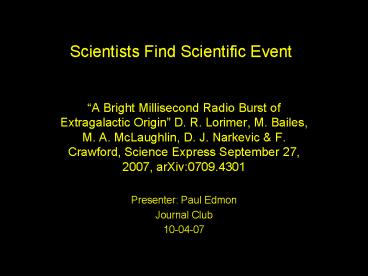Scientists Find Scientific Event - PowerPoint PPT Presentation
1 / 17
Title:
Scientists Find Scientific Event
Description:
Subtracting expected Galactic contribution: z = 0.3 which is a distance of 1 Gpc ... the cosmological rate would be about 50 per day per cubic Gpc. Problems ... – PowerPoint PPT presentation
Number of Views:23
Avg rating:3.0/5.0
Title: Scientists Find Scientific Event
1
Scientists Find Scientific Event
- A Bright Millisecond Radio Burst of
Extragalactic Origin D. R. Lorimer, M. Bailes,
M. A. McLaughlin, D. J. Narkevic F. Crawford,
Science Express September 27, 2007,
arXiv0709.4301 - Presenter Paul Edmon
- Journal Club
- 10-04-07
2
Scientists Ask Congress To Fund 50 Billion
Science Thing
3
Overview
- Observation
- Analysis
- Interpretation
- Science Ends?
4
Observation
- Burst found in archival data from a 1.4 GHz
survey of the Magellanic Clouds - Data was originally taken between May 2000 and
November 2001 - Survey Info
- 64m Parkes Radio Telescope in Australia
- 209 Telescope Pointings
- 2.3 hrs per pointing
- 13 beams per pointing on different positions of
the sky - Beam Size 5 arcmins
- Sampled every millisecond
- 96 frequency channels over 288 MHz
5
Observation
- Burst was detected on August 24, 2001
- Burst was located 3 degrees south of the center
of the Small Magellanic Cloud (SMC) - RA(J2000) 01h 18m 06s
- Dec(J2000) -75º 12 19
- Seen in three beams, saturated one of the
detectors - Follow up radio observations have not detected
any new activity
6
Observation
7
Observation
Credit Stéphane Guisard
8
Observation
9
Analysis
- Dispersion Measure (DM)
- Typical Dispersion Measures
- Galactic for this line of sight 25 cm-3 pc
- DMs for pulsars in the SMC 70,76,105,125, 205
cm-3 pc - Burst DM 375 1 cm-3 pc
- No Ha filaments or HII regions in area of burst
- Higher DM in these regions
10
Analysis
11
Analysis
- Given the high DM and offset from SMC the burst
is most likely extragalactic - Assuming a homogenous Intergalactic Medium (IGM)
which is fully ionized - DM 1200 z cm-3 pc for z 2
- Subtracting expected Galactic contribution z
0.3 which is a distance of 1 Gpc - Host Galaxy and local environment could
contribute to DM - Taking this into account z lt 0.2
- For the sake of making some estimates z.12
which is a distance of 500 Mpc - This assumes a host galaxy DM of 200 cm-3 pc
12
Analysis
- Pulse width (W) varies with frequency (f) as W a
f-4.80.4 - This is consistent with interstellar scattering
with a Kolmogorov power law W a f-4 - Given this pulse width evolution and
uncertainties in the detectors the pulse width
upper limit is 5 ms - Assuming the pulse is 5 ms the burst flux is
estimated at 30 10 Jy
13
Analysis
- Burst Estimates
- Distance 500 Mpc
- Duration 5 ms
- Flux 30 Jy
- Source
- Energy 1040 ergs
- Power 2x1042 ergs/s
- Size from Light-crossing Time 1500 km
14
Analysis
- If bursts are isotropically distributed over the
sky then the inferred rate is 225 similar events
per day - Given the above the cosmological rate would be
about 50 per day per cubic Gpc - Problems
- Only one event
- Unknown source
- Distance not well known
15
Interpretation
- What is it?
- GRB, SN?
- No detected GRB or SN at time or position
- Bizarre nature of the burst does not match any
current theory - Terrestrial?
- Telescope was pointed at a high elevation at the
time - Difficult to reproduce dispersion and scattering
profile - Non-repeating
- Rotating Radio Transient (RRAT)
- Typical pulses only detectable out to 6 kpc
- Giant Pulses
- Brightest Crab giant pulses would be detectable
out to 100 kpc
16
Interpretation
- What is it (continued)?
- Neutron Star Inspiral?
- Estimated Cosmological Rate 3 per day per cubic
Gpc - From Hansen Lyutikov (2001)
- Estimated Power extracted from orbit 1046
ergs/s - Estimated Duration 10s of seconds
- Should make X-Rays as well
- Black Hole Evaporation?
- From Rees (1977)
- Could be very fast
- Could be seen at large distances
17
Science Ends?
- Nope, Science Just Beginning!
- Need to find more of these class of bursts
- Search Pulsar surveys for single energetic bursts
- See if one can see burst at other frequencies
- Need to characterize burst
- Find host galaxy for current burst
- Figure out burst source
- If a large enough population is found
- Use for cosmology
- Use to probe ionized IGM































